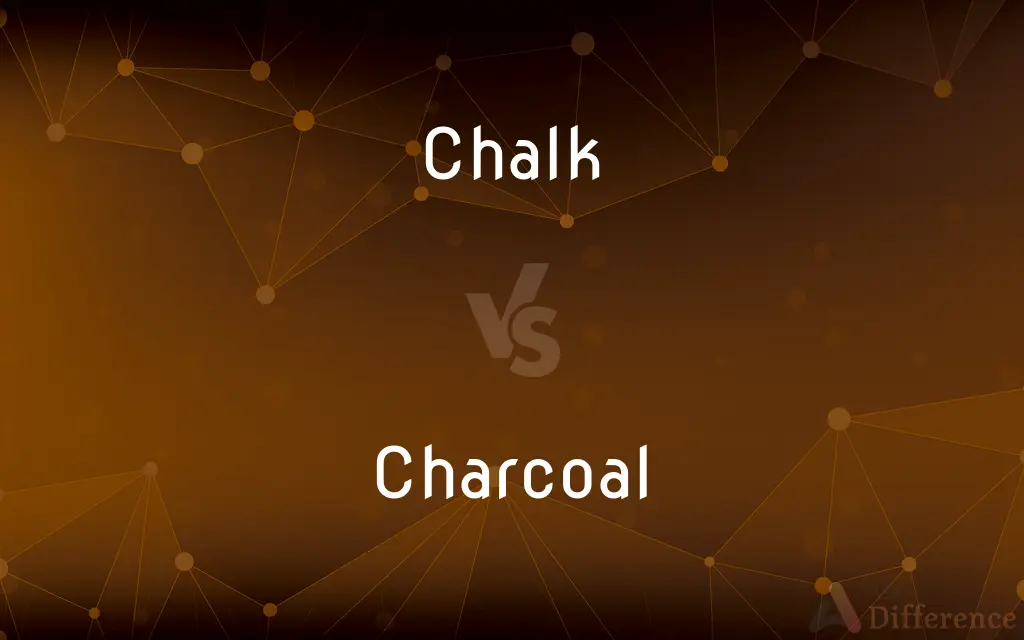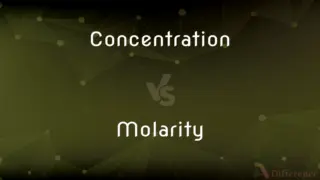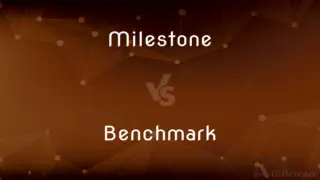Chalk vs. Charcoal — What's the Difference?
By Fiza Rafique & Maham Liaqat — Updated on April 5, 2024
Chalk is a soft, white, porous sedimentary rock used for writing and drawing, while charcoal is a dark, porous carbon residue used for sketching, grilling, and filtering.

Difference Between Chalk and Charcoal
Table of Contents
ADVERTISEMENT
Key Differences
Chalk, composed primarily of calcium carbonate, is widely recognized for its use in classrooms and art for writing on blackboards and sidewalks. Charcoal, on the other hand, is a form of amorphous carbon made by heating wood or other organic materials in the absence of oxygen, and it serves diverse purposes from drawing to fuel for barbecuing.
Chalk's natural softness allows for easy marking on rough surfaces, creating clear, white lines that can be easily erased. Whereas charcoal produces rich, dark lines that vary in shade depending on the pressure applied, offering a range of artistic effects not easily achieved with chalk.
In art, chalk is used for light, subtle marks and can be blended to create different textures and shades, ideal for highlighting and delicate work. Charcoal, due to its bold and versatile nature, is preferred for creating dramatic contrasts and deep shadows, making it a favorite for sketching and portraiture.
The manufacturing process of chalk involves mining, crushing, and milling natural limestone, while charcoal production requires the carbonization of wood at high temperatures in a low-oxygen environment, highlighting significant differences in their creation and environmental impact.
Despite both being used in art, chalk and charcoal cater to different artistic needs and preferences. Chalk offers precision and ease of use for educators and artists in light detailing, while charcoal allows for expressive and dynamic strokes crucial for depth and texture in sketches.
ADVERTISEMENT
Comparison Chart
Composition
Calcium carbonate (CaCO3).
Amorphous carbon.
Color
White or off-white.
Black or dark grey.
Use in Art
Drawing, marking, highlighting.
Sketching, creating shadows and textures.
Texture
Soft and powdery.
Coarse and can be either soft or hard.
Erasability
Easily erased with a damp cloth or eraser.
Less easily erased, often smudged.
Production
Mined from natural limestone.
Made by carbonizing wood in low-oxygen conditions.
Compare with Definitions
Chalk
A soft, white limestone used for writing and drawing.
The teacher used chalk to illustrate the problem on the blackboard.
Charcoal
A carbon-rich material made from wood, used for drawing and grilling.
Artists prefer charcoal for dynamic and expressive sketches.
Chalk
Ideal for temporary markings on surfaces.
Tailors mark fabric with chalk for cutting and sewing.
Charcoal
Essential for outdoor cooking, providing a smoky flavor.
Charcoal briquettes are a must-have for summer barbecues.
Chalk
Environmentally friendly due to its natural composition.
Chalk is preferred for its minimal environmental impact in art projects.
Charcoal
Requires careful handling to avoid smudging.
Fixatives are sprayed on charcoal drawings to prevent smearing.
Chalk
Easily erasable and perfect for classroom use.
The math formulas were quickly wiped off the board with a chalk eraser.
Charcoal
Offers deep, rich blacks in art.
The portrait's depth was enhanced with charcoal shading.
Chalk
Used in sports for grip enhancement.
Gymnasts apply chalk to their hands to prevent slipping.
Charcoal
Used in filters to purify water and air.
Activated charcoal filters are effective in removing impurities.
Chalk
Chalk is a soft, white, porous, sedimentary carbonate rock, a form of limestone composed of the mineral calcite and originally formed deep under the sea by the compression of microscopic plankton which had fallen to the sea floor. Chalk is common throughout Western Europe, where deposits underlie parts of France, and steep cliffs are often seen where they meet the sea in places such as the Dover cliffs on the Kent coast of the English Channel.
Charcoal
Charcoal is a lightweight black carbon residue produced by strongly heating wood (or other animal and plant materials) in minimal oxygen to remove all water and volatile constituents. In the traditional version of this pyrolysis process, called charcoal burning, the heat is supplied by burning part of the starting material itself, with a limited supply of oxygen.
Chalk
A white soft earthy limestone (calcium carbonate) formed from the skeletal remains of sea creatures.
Charcoal
A porous black solid, consisting of an amorphous form of carbon, obtained as a residue when wood, bone, or other organic matter is heated in the absence of air.
Chalk
Short for French chalk
Charcoal
A black, porous, carbonaceous material, 85 to 98 percent carbon, produced by the destructive distillation of wood and used as a fuel, filter, and adsorbent.
Chalk
Write or draw with chalk
He chalked a message on the board
Charcoal
A drawing pencil or crayon made from this material.
Chalk
Charge (drinks bought in a pub or bar) to a person's account
He chalked the bill on to the Professor's private account
Charcoal
A drawing executed with such a pencil or crayon.
Chalk
A soft compact calcite, CaCO3, with varying amounts of silica, quartz, feldspar, or other mineral impurities, generally gray-white or yellow-white and derived chiefly from fossil seashells.
Charcoal
A dark grayish brown to black or dark purplish gray.
Chalk
A piece of chalk or chalklike substance in crayon form, used for marking on a blackboard or other surface.
Charcoal
To draw, write, or blacken with a black, carbonaceous material.
Chalk
(Games) A small cube of chalk used in rubbing the tip of a billiard or pool cue to increase its friction with the cue ball.
Charcoal
To charbroil.
Chalk
A mark made with chalk.
Charcoal
Impure carbon obtained by destructive distillation of wood or other organic matter, that is, heating it in the absence of oxygen. Category:en:Carbon
Chalk
Chiefly British A score or tally.
Charcoal
(countable) A stick of black carbon material used for drawing.
Chalk
To mark, draw, or write with chalk
Chalked my name on the blackboard.
Charcoal
(countable) A drawing made with charcoal.
Chalk
To rub or cover with chalk, as the tip of a billiard cue.
Charcoal
A very dark gray colour.
Chalk
To make pale; whiten.
Charcoal
Of a dark gray colour.
Chalk
To treat (soil, for example) with chalk.
Charcoal
Made of charcoal.
Chalk
(uncountable) A soft, white, powdery limestone (calcium carbonate, CaCO3).
Chalk cliffs are not recommended for climbing
Charcoal
To draw with charcoal.
Chalk
(countable) A piece of chalk, or nowadays processed compressed gypsum (calcium sulfate, CaSO4), that is used for drawing and for writing on a blackboard (chalkboard).
The chalk used to write on the blackboard makes a squeaky sound
Charcoal
To cook over charcoal.
Chalk
Tailor's chalk.
Charcoal
Impure carbon prepared from vegetable or animal substances; esp., coal made by charring wood in a kiln, retort, etc., from which air is excluded. It is used for fuel and in various mechanical, artistic, and chemical processes.
Chalk
A white powdery substance used to prevent hands slipping from holds when climbing, or losing grip in weight-lifting or gymnastics, sometimes but not always limestone-chalk, often magnesium carbonate (MgCO3).
When working out your next move, it's a good idea to get some more chalk from the bag
Charcoal
Finely prepared charcoal in small sticks, used as a drawing implement.
Chalk
A platoon-sized group of airborne soldiers.
Charcoal
A carbonaceous material obtained by heating wood or other organic matter in the absence of air
Chalk
The favorite in a sporting event.
Charcoal
A stick of black carbon material used for drawing
Chalk
The prediction that there will be no upsets, and the favored competitor will win.
Charcoal
A very dark gray color
Chalk
To apply chalk to anything, such as the tip of a billiard cue.
Chalk your hands before climbing
Charcoal
A drawing made with charcoal
Chalk
To record something, as on a blackboard, using chalk.
Charcoal
Draw, trace, or represent with charcoal
Chalk
To use powdered chalk to mark the lines on a playing field.
Charcoal
Very dark gray
Chalk
(figuratively) To record a score or event, as if on a chalkboard.
Chalk
To manure (land) with chalk.
Chalk
To make white, as if with chalk; to make pale; to bleach.
Chalk
A soft, earthy substance, of a white, grayish, or yellowish white color, consisting of calcium carbonate, and having the same composition as common limestone.
Chalk
Finely prepared chalk, used as a drawing implement; also, by extension, a compound, as of clay and black lead, or the like, used in the same manner. See Crayon.
Chalk
To rub or mark with chalk.
Chalk
To manure with chalk, as land.
Chalk
To make white, as with chalk; to make pale; to bleach.
Let a bleak paleness chalk the door.
Chalk
A soft whitish calcite
Chalk
A pure flat white with little reflectance
Chalk
Amphetamine used in the form of a crystalline hydrochloride; used as a stimulant to the nervous system and as an appetite suppressant
Chalk
A piece of chalk (or similar substance) used for writing on blackboards or other surfaces
Chalk
Write, draw, or trace with chalk
Common Curiosities
How is charcoal produced?
Charcoal is produced by heating wood or other organic materials in the absence of oxygen, a process known as pyrolysis.
Why is chalk preferred in classrooms?
Chalk is preferred for its ease of use, erasability, and the clear visibility of its markings on blackboards.
Is charcoal environmentally friendly?
Charcoal can be environmentally friendly if sourced from sustainable wood and produced efficiently, though its production process emits carbon dioxide.
Can both chalk and charcoal be used together in art?
Yes, artists often use both chalk and charcoal together to utilize their contrasting qualities for dynamic and textured effects.
What is chalk made of?
Chalk is primarily composed of calcium carbonate (CaCO3), derived from mineral limestone.
What are the environmental impacts of mining chalk?
While generally low, the environmental impact of mining chalk can include landscape disruption and habitat destruction if not managed responsibly.
Is there a difference in the hardness of chalk and charcoal?
Yes, chalk is uniformly soft, while charcoal can vary in hardness depending on how it is produced.
Can charcoal be used for anything besides art and grilling?
Yes, charcoal is also used in water and air purification systems due to its excellent filtering properties.
Can chalk be used for sketching like charcoal?
Yes, chalk can be used for sketching, especially for light and subtle effects, but it lacks the depth and intensity of charcoal.
Is chalk harmful to human health?
Chalk is generally considered non-toxic, but inhaling chalk dust over long periods can irritate respiratory passages.
Why is charcoal preferred for grilling?
Charcoal is preferred for its ability to reach high temperatures and impart a distinct smoky flavor to the food.
How long have humans been using chalk and charcoal?
Humans have used both chalk and charcoal for thousands of years, with evidence dating back to prehistoric cave paintings.
How do you prevent charcoal drawings from smudging?
Fixatives are sprayed onto charcoal drawings to protect them from smudging and preserve the artwork.
How do artists choose between chalk and charcoal?
Artists choose based on the desired effect; chalk for light and subtle work, and charcoal for bold, dramatic impressions.
Are there different types of charcoal?
Yes, there are several types, including vine charcoal for softer, lighter marks, and compressed charcoal for darker, more intense lines.
Share Your Discovery

Previous Comparison
Concentration vs. Molarity
Next Comparison
Milestone vs. BenchmarkAuthor Spotlight
Written by
Fiza RafiqueFiza Rafique is a skilled content writer at AskDifference.com, where she meticulously refines and enhances written pieces. Drawing from her vast editorial expertise, Fiza ensures clarity, accuracy, and precision in every article. Passionate about language, she continually seeks to elevate the quality of content for readers worldwide.
Co-written by
Maham Liaqat















































